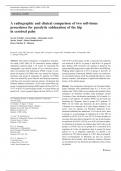Exam (elaborations)
A radiographic and clinical comparison of two soft-tissue procedures for paralytic subluxation of the hip in cerebral palsy
- Course
- Institution
Paralytic subluxation of the hip (PSH) occurs in patients with cerebral palsy (CP) because of a muscle imbalance between the stronger hip flexors and adductors and the weaker hip extensors and abductors. This imbalance causes joint contractures which then lead to migration of the femoral head ...
[Show more]



